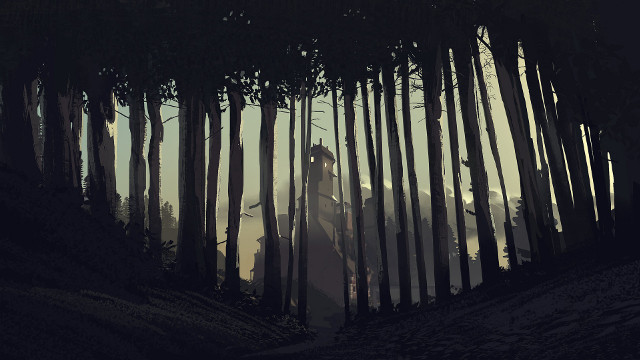I won’t know how I feel about What Remains of Edith Finch until it’s over. It’s a tough game to preview, since it’s a very story-focused title. Yes, it’s more than your ordinary “walking simulator,” offering the occasional divergence; like a clunky platformer, a clunky flying sim, or, uh, a part where you play as a huge-ass snake. But the moments that evoke games like Gone Home or The Vanishing of Ethan Carter — the moments you expect from a game like this — are the best parts of Edith Finch.
The eponymous Edith Finch is both narrator and player character (for the most part, but we’ll get to that), returning to her childhood home after her mother’s passing. Ms. Finch has left Edith a key to the house that doesn’t just unlock the front door…it also unlocks plenty of secrets. The Finch ancestral home is taller than it is wide, extending into the sky like a scrappy radio tower. You see, as members of the Finch family die, their bedrooms were sealed off and a new room was constructed in its place. As Edith pokes around each bedroom, the player is treated to a vignette showing how that member of the Finch clan met their untimely end.
I played Molly’s death scene first. She was a child who had been sent to bed without dinner, so she ate an entire tube of toothpaste, some old gerbil food, and some poison berries. RIPD Molly, right? Once she ate the berries, I thought I knew what was going to happen. I was all set for some good old fashioned self-infanticide, it was the perfect way to end that section of the game. But where I expected the game to zig, it zagged. As the player moves towards a nearby window, they become a cat, leaping across trees in the hopes of catching & eating a bird. And then you’re an owl, picking off rabbits in a field. Then you’re a shark, ripping apart a seal. Then you’re some kind of snake monster on a boat, eating people. The snake monster eventually slips into the water, goes through a pipe, comes out Molly’s toilet, and hides under her bed.
All of this is narrated by Molly. Towards the end, she believes there’s some kind of monster under her bed that will eat her as soon as she’s finished writing. (Except it’s also her, because she became the monster?) Her final line, “We both know that I will taste delicious,” is macabre as all-get-out, and I dug it. I also liked the sense of magical realism I got from this scene, as the game wants you to at least consider the validity of Molly’s vision. The mechanical diversion is less exciting, it’s just too clunky. I couldn’t get lost in the game’s vision. It also goes on a bit too long — I “got” the idea long before the sequence was over. Representing the cause of death through an abstract gameplay sequence is really cool, but maybe it should not play like garbáge.
The game is framed through some kind of flashback, as a mystery character paws through the journal Edith wrote as she explored the house. Here’s my bet: the other player character, the one going through Edith’s journal, is Edith’s missing brother, Milton. Edith has been literally sketching in her family tree, assigning a portrait to each name, and every person is drawn in a specific art style — except for Milton. Since he was a painter, his portrait evokes his self-portraits. That already sets him apart from the other characters. He’s got a cast on his arm because their mom was abusive, so he ran away. Edith has been dead the whole time, that’s why her portrait ends in “2017” rather than a dash or question mark or something. Just like she’s reading something written by a dead Finch, Milton is doing the same.
One quick note: the pre-release PlayStation 4 version I played was plagued by constant slowdown, most notable during Edith’s journey towards the Finch house. Supposedly, it’s a streaming issue brought on by the limitations of the PS4 hardware, not a framerate issue, and won’t be a problem for the PC version. PS4 Pro owners hoping to sidestep the slowdown are out of luck; I was told the upgraded hardware likely wouldn’t address the problem. The game is still a few months out from completion, so there’s still time for the dev team to fix the issue, but it’s still worth noting.
There’s a lot to appreciate about Edith Finch’s story, so I’ve got hopes for everything that reminds me of Gone Home. I like the idea that Edith is now the sole keeper of the family secrets after her mother’s death, as is so often the case in real life after a parent passes. I think the melancholy that surrounds the house is palpable, and the game has a strong handle on the type of atmosphere it’s aiming for. The idea that you’ll be seeing the last moments of ten different people is such a delightfully grim idea — mixing it with magical realism is the fondant that holds this cake together, keeping the whole enterprise from being consumed by darkness.
I like magical realism, and I’m happy to see more of it in video games. If that’s how Edith Finch plans to stand apart from the many other narrative-focused video games currently on the market, that’s OK by me. The mechanical diversions are a great idea, hypothetically allowing each death to be represented in an abstract manner that also breaks up the moment-to-moment gameplay loop. Hopefully the rest of the game is better than Molly’s story, since her metaphor was fairly obvious and not all that fun to play. What remains of Edith Finch? I guess we’ll just have to find out next year!!
(I’m sorry)







